Replaces
2006 GMC Sierra 1500 4 Wheel Drive with Front Coil Spring Suspension with 4 Groove Pitman Arm with 6 Lug Wheels with Cast Iron Lower Control Arms with Steering Gear without Aluminum Steering Knuckles Front 10 Piece Steering & Suspension Kit TRQ PSA85926
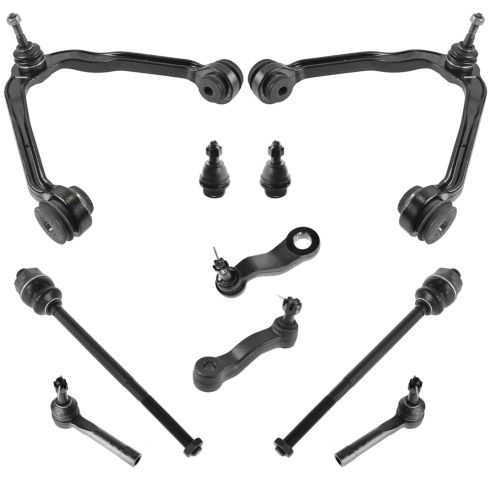


PSA85926
In Stock
This part doesn’t fit a . Select from parts that fit.
Specify your vehicle's year, make and model to guarantee fit.
Orders must be placed by 2pm ET

You may also like
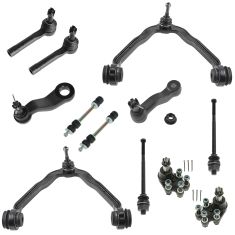
12 Piece Steering & Suspension Kit
$195.95
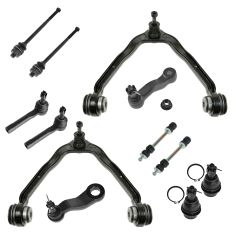
12 Piece Steering & Suspension Kit
$199.95
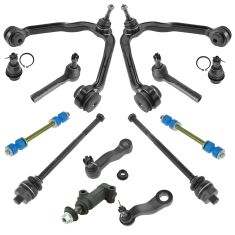
13 Piece Steering & Suspension Kit
$234.95
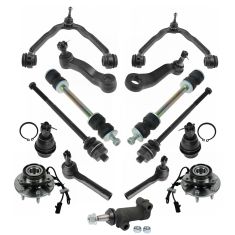
15 Piece Steering, Suspension, & Drivetrain Kit
$339.95
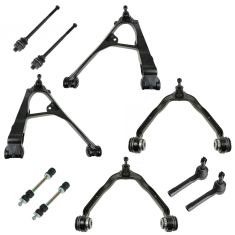
10 Piece Steering & Suspension Kit
$379.95
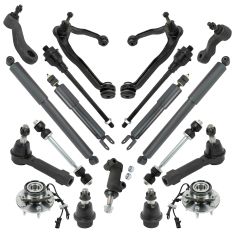
19 Piece Steering, Suspension, & Drivetrain Kit
$424.95
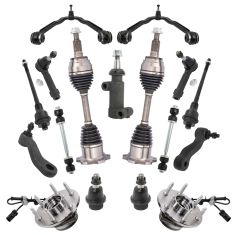
17 Piece Steering, Suspension, & Drivetrain Kit
$514.95
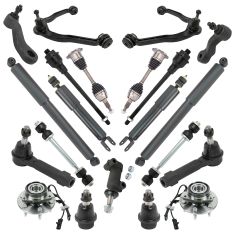
21 Piece Steering, Suspension, & Drivetrain Kit
$549.95
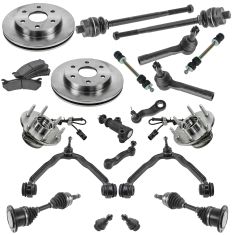
Ceramic 20 Piece Steering, Suspension, & Brake Kit
$634.95
Part Details
- Quantity: 10 Piece
-
Kit Includes:
(2) Front Lower Ball Joints
(2) Front Outer Tie Rods
(1) Idler Arm
(2) Front Upper Control Arms with Ball Joints
(1) Pitman Arm
(2) Front Inner Tie Rods
Specification
- with Front Coil Spring Suspension
- with 6 Lug Wheels
- 4 Wheel Drive
- with Steering Gear
- without Aluminum Steering Knuckles
- with Cast Iron Lower Control Arms
- with 4 Groove Pitman Arm
- Front
TRQ suspension kits are manufactured using premium raw materials and coatings for extended service life. Each TRQ suspension component is designed to be a direct, maintenance-free replacement to the stock unit. To extend the life of your steering and suspension components, TRQ recommends replacing components in pairs, sets, or kits. All products are fit and road-tested in our Massachusetts R&D facility to ensure we deliver on our promise of Trusted Reliable Quality.
Product Features
Install Tip: When replacing steering components, have a professional alignment performed afterwards. This ensures proper tracking and even tire wear.
Our steering and suspension components are pre-greased and sealed for long life and do not require the extra maintenance typically required by greaseable versions.
Item Condition:
New
Attention California Customers:
![]() WARNING: This product can expose you to chemicals including Lead and Lead Compounds, which are known to the State of California to cause cancer, and birth defects or other reproductive harm. For more information, go to www.P65Warnings.ca.gov.
WARNING: This product can expose you to chemicals including Lead and Lead Compounds, which are known to the State of California to cause cancer, and birth defects or other reproductive harm. For more information, go to www.P65Warnings.ca.gov.
Lifetime Warranty
This item is backed by our limited lifetime warranty. In the event that this item should fail due to manufacturing defects during intended use, we will replace the part free of charge. This warranty covers the cost of the part only.
FREE Shipping is standard on orders shipped to the lower 48 States (Contiguous United States). Standard shipping charges apply to Hawaii and Alaska.
Shipping is not available to a P.O. Box, APO/FPO/DPO addresses, US Territories, or Canada for this item.
Expedited is available on checkout to the United States, excluding Alaska, Hawaii.
Final shipping costs are available at checkout.






Created on:
Tools used
- Raise and secure the vehicle Measure the length of the inner tie rod to the outer tie rod with a tape measure Measure this length at extension and in compression Note those measurements Clean grease from the inner tie rod fitting Loosen the inner tie rod from the steering rack with an adjustable wrench Hold the outer tie rod in place with a wrench Loosen the inner tie rod from the outer tie rod with the adjustable wrench Remove the tie rod at the steering rack Turn the inner tie rod counterclockwise to remove it from the outer tie rod
- Apply thread lock to the threads on the steering rack side of the inner tie rod Use a floor jack to keep the stabilizer link above the working area Thread the inner tie rod on to the steering rack Tighten the inner tie rod to between 70 – 80 foot-pounds of torque Twist the nut onto the outer end of the inner tie rod by hand Turn the tire in to push the inner tie rod into the outer tie rod
- Measure the length of the inner tie rod to the outer tie rod with a tape measure Turn the inner tie rod with the adjustable wrench until its length is the noted length from Step 1
- Use a grease gun to add grease to the inner tie rod fitting Add grease until the tie rod boot starts to change shape Add grease to other fittings as necessary
Brought to you by 1AAuto.com, your source for quality replacement parts and the best service on the Internet.
Hi, I'm Mike from 1A Auto. I hope this how-to video helps you out, and next time you need parts for your vehicle, think of 1AAuto.com. Thanks.
In this video, I'm going to replace an inner tie rod on this 2002 GMC Sierra. This procedure is the same for millions of GMC Sierra, Chevy Silverado, 1500 and 2500, 3500, pretty much all the same basic procedure. You'll need a couple of large adjustable wrenches. I found those work fine. You don't really need the exact size. Two large adjustable wrenches will work.You'll also need a tape measure and you'll need a grease gun with grease, and we do recommend that you have your vehicle aligned after a repair like this.
Here you can see, I have the vehicle up on a lift. Here is my inner tie rod running from here to here. This is the outer tie rod. You could see, I pull this boot down and I pull and what I'm looking at is basically the relationship of here to here and I can see some movement in here. I want to replace this. What I'm going to do is, I'm going to pull out, then I'm going to measure from there to there. Just a shade under ten inches, 9 and 15/16"?. Now, I'm going to pull it back in, and check here. It's about 9 and 7/8"?. When I put this back together, I'm going to set this right between 9 and 7/8"? and 9 and 15/16"?. I'm going to pull it apart. I'm just going to clean this off.
Take a nice big adjustable wrench. I'm loosening that up. On this end, I'm going to put a wrench on my outer tie rod just to hold it in place. We'll get that loosened up. I'm just going to speed up here. We loosened up the nut that's close to the center steering rack and then we loosened up the tie rod where it connects the outer tie rod. Take that nut off for the center steering first and then just turn the whole entire inner tie rod counter clockwise and take it out of the outer tie rod.
Here's a new tie rod from 1A Auto. It's always a good idea to put some thread lock on the inside. If you have your vehicle up on a lift, or a jack, you'll want to jack it up just to get, make sure your stabilizer bars up and out of the way. Thread it in and then use a wrench and tighten this. This should be tightened to 74 foot-pounds. Anywhere between 70 and 80 foot-pounds. In this shot, what I didn't explain very clearly, you can see where that red arrow is. I have a jack underneath the suspension. It just helps lift it up so that the stabilizer bar isn't in the way when you start the tie rod into the center steering link. With this wrench, just pull it nice and tight. Now I'm going to assemble the outer end. I'm going to put this nut on. Then to bring this down on my tire and in. Make sure it's going together straight. If you remember our measurement, basically, we want to be right at 9 and 31/32, so we've got a long way to go. I'm going to speed it up here as I keep using the wrench to turn the tie rod end into the outer tie rod end. I measured a couple of times just to see where I'm at. That is, it's just a little bit further than we want. Knock it off, right there. We've got our one wrench on here and then to tighten, hold on to the outer tie rod, taking that up nice and secure. Now make sure we grease the fitting. What I'm watching, I'm watching this boot here. Once that boot starts changing shape a little bit, I know the grease is in there. Then, while on here. I'm going to hit all my other grease spots as well.
We hope this helps you out. Brought to you by www.1AAuto.com, your source for quality replacement parts and the best service on the Internet. Please feel free to call us toll-free, 888-844-3393. We're the company that's here for you on the Internet and in person.
Tools used
- Loosen the lug nut covers with a 22mm socket Pry off the center cap by hand Loosen the lug nuts with the vehicle on the ground Raise the vehicle with a floor jack Secure the vehicle on jack stands Remove the lug nuts Pull off the wheel
- Measure the distance from the boot of the inner tie rod to the edge of the outer tie rod Make note of this measurement Loosen the nut that holds the outer tie rod to the inner tie rod with an adjustable wrench Remove the 18mm nut from the outer tie rod end Strike the steering knuckle with a hammer to loosen the outer tie rod Pull the outer tie rod out of the steering knuckle Hold the nut that holds the outer tie rod to the inner tie rod with an adjustable wrench Twist off the outer tie rod by hand
- Attach the grease fitting to the new outer tie rod Tighten the grease fitting with a 7mm socket and ratchet Twist the new outer tie rod onto the inner tie rod Push the outer tie rod into the steering knuckle Fasten the 18mm castle nut onto the outer tie rod Push the cotter pin through the castle nut Twist the cotter pin into place with needle nose pliers Fill the tie rod with grease, using a grease gun Measure the distance from the boot of the inner tie rod to the edge of the outer tie rod This should be the same as the measurement noted in Step 2 Tighten the nut that holds the outer tie rod to the inner tie rod with an adjustable wrench
- Slide the wheel into place Start the lug nuts by hand Tighten the lug nuts preliminarily Lower the vehicle to the ground Tighten the lug nuts to 100 foot-pounds in a crossing or star pattern Reattach the center cap Tighten the lug nut covers with a 22mm socket
Brought to you by 1AAuto.com, your source for quality replacement parts and the best service on the Internet.
Hi, I'm Don from 1A Auto. I hope this how-to video helps you out, and next time you need parts for your vehicle, think of 1AAuto.com. Thanks.
In this video, we're going to show how to replace an outer tie rod on this 2002 Chevy Suburban, and it's the same part and similar process on these Suburbans from 2001 to 2006. We show you on the passenger side, but the driver side is the same procedure. The items you'll need for this are a new outer tie rod from 1AAuto.com; 7mm, 13mm, 18mm and 22mm socket and ratchet; flat-blade screwdriver; adjustable wrench; tape measure; pliers; hammer; and a grease gun.
You want to just loosen up these 22mm caps, and then pull the hubcap free. Then, you want to loosen these lug nuts while the vehicle is on the ground, then raise the vehicle and remove them the rest of the way, unless you have air-powered tools. Then, you can do it while it's in the air.
Now you want to measure from the boot on your inner tie rod to the edge of your outer tie rod and just remember that measurement. Now, using your adjustable wrench, loosen up this nut right here, and then you want to remove this 18mm nut down here. Now just hit on your knuckle with a hammer and this is going to break up that outer tie rod and make it easier to pull out. Now just hold this nut with the adjustable wrench, pull the outer tie rod off and just twist it until it comes free. We'll fast forward as Don does this. You want to make sure that the inner tie rod doesn't spin while you're removing the outer tie rod.
Now, put the grease fitting into your new outer tie rod and just tighten that 7mm grease fitting up. Then twist the outer tie rod back onto your inner tie rod and push it down into place. Now, replace the castle nut and just tighten that up. Then push the cotter pin through and, using your pliers, just bend the ends of it. Now, using your grease gun, fill the tie rod with grease. Measure, and you should get about the same distance. That's a good preliminary alignment. You should have your car aligned after this. Tighten up the lock nut to hold it in place.
Now replace your wheel and then replace those lug nuts and tighten them preliminarily. Lower the vehicle and tighten them the rest of the way. Now torque the lug nuts in a crossing pattern to 100 foot-pounds. Replace the hubcap and tighten up those caps.
We hope this video helps you out. Brought to you by www.1AAuto.com, your source for quality replacement parts and the best service on the Internet. Please feel free to call us toll-free, 888-844-3393. We're the company that's here for you on the Internet and in person.
Tools used
- Straighten out the cotter pin Remove the cotter pin Loosen and remove the castle nut Insert a two-jaw puller on both sides of the steering arm Tighten the puller to break the idler arm free Remove the 21mm nuts from the idler bracket Remove the idler arm and bracket
- Remove the 24mm nut on the idler arm Remove the idler arm from the idler arm bracket with a two jaw puller
- Slide the arm onto the bracket Tighten the 24mm bolt to the idler arm with a 12mm and 24mm wrench Grease the idler arm and bracket
- Slide the idler arm into place Hand-tighten the 21mm bolt to the bracket Hand-tighten the castle nut Tighten the 21mm bolts to the idler arm bracket Tighten the 21mm castle nut Slide the cotter pin into the castle nut Bend the cotter pin to secure the nut
Hi, I'm Mike from 1AAuto. We've been selling auto parts for over 30 years! We're dedicated to delivering quality auto parts, expert customer service, and fast and free shipping, all backed by our 100% satisfaction guarantee. We've created thousands of videos to help you install our parts with confidence. That saves you time and money, so visit us at 1AAuto.com, your trusted source for quality auto parts.
All right, to find the idler arm on your truck—it's on the passenger side—is to start at the tie rod end and just follow the arm all the way to your inner tie rod and then up to your idler arm. The idler arm is on the passenger side, and it bolts to the frame of the vehicle and to the steering itself. You can watch the play in it by just moving the tire back and forth forcefully with your hand. There shouldn't be any sort of play in between the idler arm and the steering shaft itself. That is actually the problem here. The vehicle failed inspection because there's too much play here. It's actually to a point where it's actually becoming dangerous, because this is actually going to break apart pretty soon. We want to get in here and replace the idler arm.
The first step to removing the idler is removing the cotter pin that holds the nut in place. I think to use a pair of cutters to grab it with. It's usually the easiest thing to do, although I may prove myself wrong. There we go. Then you can also use a pair of locking pliers to pull it from the other side. Then you'll take your 21-millimeter socket with an extension, and I'm using a 1/2 inch ratchet because it's going to be pretty tight, and we'll crack it loose. Luckily it's greasy, so once you crack it loose it usually spins right off.
Ideally, you want to have a puller, which you can get from your local hardware store or auto parts store. You can usually rent them. You'll want to put it on like this. We're using a two jaw puller. It wraps up on both sides of the steering arm, and then the center bolt pushes right on the idler arm. Then in our case it's a 16-millimeter right here, but depending on the puller it could be a different size. At that point, you want to just tighten up your puller until the idler arm breaks free. We're going to be pulling off the idler arm with the idler arm bracket, so we need to take out the lower nut right here and then the upper one right up here.
In New England, we like to spray everything with rust penetrator because we take it off because it just makes life a lot easier. On the front side of the bracket, there's the actually heads of the bolt that we're going to put a socket on. Right here is the lower one. Then up here is the upper one. We're going to use a 21-millimeter with an extension and a little wobble adapter so that we can get on there. It's not the easiest thing to reach, but once you're on there it should stay there. Then on the backside we'll put a wrench to hold the nut in place, and hopefully turn it.
Now we're heading for the top bolt on the idler arm bracket. We have our 21-millimeter wrench on the backside and then 21-millimeter socket and extension on the front. At this point, we'll be able to just pull the whole idler arm and its bracket right out of the truck like so. With the idler arm off the truck, we put it in a vice, and you can see how much movement there is in it. There obviously shouldn't be any. That should be nice and tight.
We've cleaned up our idler arm and idler arm bracket. Both are well used, but we're going to show you how to separate the idler arm from the bracket itself. In our case, there's a 24-millimeter nut on here. That may differ depending on if your car has an original OEM part or if it's been replaced before. In our case, it's 24-millimeter. We're going to throw it in the vice and put our 24 millimeter socket on with a 1/2 inch ratchet because you want plenty or torque, and hopefully we can crack this loose. With the nut off, now we have to pull the idler arm off the idler arm bracket.
Once again I'm going to reposition this in the vice. Get a puller, which you can rent from a local hardware store or an auto parts store, or they're actually not too expensive if you just buy them and you think you might be doing this more than once. It might be worth buying a kit to do this. Then you'll tighten down the center bolt. In our case, we have a 16-millimeter on the top of the puller, which we will once again use our 1/2 inch ratchet to tighten up. You always want to wear your safety glasses when you're doing these things, safety gloves, because things tend to spring off when you're least expecting it, kind of like that. Now that it's broken loose, you can pull it right off.
Here are the idler arms. You can see the old one right here. This one has a ton of play in this section. I think it's probably due to the fact that somebody didn't grease this on a regular basis. Usually, if you put the grease in and then forget about it for the next 100,000 miles, it's going to wear out the inside, and you're going to need to replace the whole thing again. This one obviously comes with a new greaseable fitting on the top. The key is you just want to make sure that you properly grease these on a regular basis, and it'll pretty much last as long as you take care of it. It also does come with a little foam piece on the bottom like the original has. Yeah, it looks, feels, and acts just like the original.
In our case, we're going to be replacing the idler arm bracket and the idler arm, and this is the same process, whether you're replacing one or the other, but we always recommend doing them both at the same time since you have them both out of the vehicle. It's just a really easy thing and it doesn't cost a whole lot more, or a whole lot more money to swap them both at the same time. To do this, we'll hook the idler arm bracket into the vice and we'll slide the idler arm right onto the bracket. Put the nut on there. This happens to be a 24-millimeter. Depending on what kind of part you have in your car, it may vary. The size may vary a little bit.
At this point, we can tighten this up. We started tightening the nut, and we found that the whole thing was spinning, like you can see here. That's why they put a hex on the top of this, so that you can put a wrench here and a wrench on the bottom, and then you can tighten down the nut much easier. While the idler arm bracket and idler arm are out of the vehicle, we're going to put the grease in them. That way it's a little bit easier on us once they're installed. Now we can slide the whole assembly right back in. There's one bolt in place. Now we'll do the lower bolt, which is a little trickier.
All right, with the top, or with the idler arm bracket bolts in place, then you can push the idler arm into the steering and tighten up the castle nut, or hand tighten the castle nut. Now we're going to take our 21-millimeter socket and extension and place it on the upper bolt and put a wrench on the backside. Of course, we want to turn the ratchet in the proper direction, and we'll start tightening up that bolt. All right, then we'll go for the lower one, which again 21-millimeter with a ratchet and extension and 21-millimeter on the back.
Now we have the 21-millimeter idler arm nut that we are going to use a ratchet and extension and socket on. We want to get it tight enough so that it is held in place, but we also want to line up the castle nut with the hole in the idler arm so that we can get the cotter pin through. Now you can slide the cotter pin through the hole and bend it over so that it stays in place. Now you'll see that when we move the wheels back and forth, the play between the idler arm and the steering bracket no longer exists.
Thanks for watching. Visit us at 1AAuto.com for quality auto parts, fast and free shipping, and the best customer service in the industry.
Tools used
- Loosen the three 21mm bolts holding the steering box to the frame Remove the 21mm castle nut on the ball joint end of the pitman arm Remove the pitman arm from the steering linkage with a two jaw puller or a pickle fork Pull the pitman arm out of the steering linkage Hold the steering box in place Remove the 34mm nut on the pitman arm Insert the two jaw puller to the pitman arm Pry the pitman arm off of the steering box Remove the pitman arm from the truck
- Grease the pitman arm with a grease gun Insert the pitman arm up into place Attach the washer and 34mm bolt Tighten the 34mm bolt Press the pitman arm into the steering linkage Hand-tighten the castle nut Hand-tighten the three 21mm bolts into the steering box Tighten the steering box bolts Tighten the 19mm castle nut Insert the cotter pin into the castle nut Bend the cotter pin
Hi, I'm Mike from 1AAuto. We've been selling auto parts for over 30 years! We're dedicated to delivering quality auto parts, expert customer service, and fast and free shipping, all backed by our 100% satisfaction guarantee. We've created thousands of videos to help you install our parts with confidence. That saves you time and money, so visit us at 1AAuto.com, your trusted source for quality auto parts.
The pitman arm is attached to the steering box itself, and you can find it right up on the driver side of the vehicle. It is right here attached to the steering box, and then attached to part of the steering linkage as well. Typically, these wear out right at the ball joint end of it. It comes as a whole lot of slop in your steering wheel.
To access the large nut on the bottom of the Pitman arm, you have to actually loosen or remove the steering box from the frame of the truck, and we'll start that by removing the three 21 millimeter bolts that are on the driver side of the frame that hold the steering box to the frame itself. We'll start grabbing a 21 millimeter socket and a large ratchet. There's going to be a lot of force on these, so we want to use a long ratchet to do it. Right here on the ball joint end of the Pitman arm, you're going to want to remove this 21 millimeter nut with a socket and an extension. Hopefully it goes on.
With the nut off, now we have to separate the Pitman arm from the steering linkage. There's a couple ways to do this. You could use a pickle fork. I actually prefer using a puller because that is usually the most successful way that I have. You can usually rent these from a hardware store or a local auto parts store, or they're actually not too expensive to just purchase. We'll put a 16 millimeter on the puller and start putting some force on it. You basically swing it up your steering box, pull down on the linkage, and now it is somewhat out of the way.
Now you have access to the 34 millimeter nut on the bottom of the Pitman arm. This 34 millimeter nut is really, really tight, and the steering box is obviously loosened from the frame. So we need to hold the steering box in place somehow while we loosen this nut with a very large ratchet. I think what I'm going to do is I'm going to take a large wrench, put it on this side of the frame, and run one of the steering box bolts through it and back into the steering box. Now I'm going to put a 34 millimeter socket on there with a breaker bar or a half inch drive ratchet that's quite long, and hopefully we can crack this loose.
Now we're going to take our puller and put it on the Pitman arm itself. Going to have to wiggle the steering box around a little bit and kind of get things out of the way to make sure that you have room to actually use the puller. You always want to make sure it's centered on the bolt as well because the puller won't work if it's crooked. We're going to use a ratcheting wrench in this case to tighten up the puller. The Pitman arm is not coming off with the puller, so we're going to throw a little heat on it to try and loosen it up. All right. With the Pitman arm loose, you should be able to pry it right off the steering box and hopefully pull it out of the truck.
As you can see, we got the old Pitman arm and the new Pitman arm. If you're buying a Pitman arm for one of these trucks, you'll need to know if it's a four-spline or a three-spline. What that means is inside here, in this case there's four wider splines so it can only go on one of four directions. You can see there's one here, there's one on here, and if you turn it 90 degrees you can see there's one here and one here. On the three-spline, it's triangular. You can see that they are essentially the same part. The new one comes with the castle nut and the cotter pin so that you can set it up right. It'll look and fit and function just like the original.
I prefer to have it greased before I put it in the truck because it's a little easier to grease now than when it's installed, so I have it clamped in the vice, put the grease can on it, and then just add the grease until it's full. You'll know it's full because it kind of oozes out the bottom seal. You don't want to blow out the seal completely, but as soon as you see it pop up the seal you know it's full. All right, before we put the Pitman arm back in, I'm going to take this bolt out of the steering box that I was using earlier to hold it in place. It'll give me a little freedom to work around it.
Now we can take our new Pitman arm and slide it up into place. The Pitman arm only fits on one of four ways, so there's a very good chance that you're just going to plop it on and get it right the first time. If it was wrong, it would be 90 degrees off in either direction, so I'm very confident that we have it right because it is a four-spline setup and this is really the way it came off. Next we can take the washer and the large 34 millimeter nut and put it onto the steering box.
All right, with the bolt loosely in place we can get the steering box to a place where we can get our 34 millimeter socket onto there. Then we can tighten it up. You're going to want to tighten this basically as tight as you can. If you have some air tools, air tools work really great for this. Now we're going to put this ball joint end of the Pitman arm back into the steering linkage just like that, and we'll hand tighten the castle nut onto the Pitman arm.
Now we can put in the three steering box bolts. We're just going to hand tighten them each for now. Now we're going to take your 21 millimeter socket and ratchet and we can tighten up these steering box bolts. Now we can tighten up this one. The new one actually has a 19 millimeter nut on it, so we'll just tighten that up. You'll want to line it up with the hole in the center of the bolt so that we can put a cotter pin through it to hold it in place.
Thanks for watching. Visit us at 1AAuto.com for quality auto parts, fast and free shipping, and the best customer service in the industry.
Tools used
- Loosen the 22mm caps on the hubcap with the vehicle on the ground Pull the hubcap free Raise the vehicle with a floor jack Secure the vehicle on jack stands Remove the lug nuts Pull off the wheel
- Mark the tab on the adjustment piece with a marker to mark the alignment Remove the two 10mm bolts holding the brake line and move the brackets Remove the ball joint nut with an 18mm wrench Hit the wheel knuckle and control arm to break them free Remove the 21mm nuts from the upper control arm bracket Jack up the wheel underneath the wheel knuckle Remove the upper control arm nut Remove the bolts and upper control arm bracket Place a nut back on and use an air hammer to knock the bolt out if it won't budge Move the control arm up and down while pulling out
- Put the upper control arm into place and push the 21mm bolts in to hold it Put the brackets on either side and realign them up Angle the control arm down into the wheel knuckle Replace the 18mm ball joint nut Replace the 21mm nuts from the upper control arm bracket Replace and tighten the two 10mm bolts Put a grease gun into place on the end of the control arm and fill it up
- Slide the wheel into place Start the lug nuts by hand Tighten the lug nuts preliminarily Lower the vehicle to the ground Tighten the lug nuts to 100 ft/lbs in a crossing or star pattern Reattach the hubcap and tighten the caps
Brought to you by 1AAuto.com, your source for quality replacement parts and the best service on the Internet.
Hi, I'm Mike from 1A Auto. I hope this how-to video helps you out, and next time you need parts for your vehicle, think of 1AAuto.com. Thanks.
In this video, we're going to show you how to replace an upper control arm on this 2002 Chevy Suburban. We show you on the passenger side, but the driver side has the same procedure. The items you'll need are a new upper control arm from 1AAuto.com, a 10mm, 21mm, and 22mm socket and ratchet, 18mm and 21mm wrench, a marker, a torque wrench, jack and jack stands, a grease gun, a hammer, and an air hammer depending on the condition of your vehicle. After completing this procedure you will need to get a professional alignment done.
Start out by removing the hubcap. You want to remove the lug nuts. If you don't have air powered tools, you'll want to do it while the vehicle is on the ground. Loosen them preliminarily, raise the vehicle, and remove the lug nuts the rest of the way. On these brackets, you'll see a tab coming through from the upper control arm. Mark where that tab is. Remove these two 10mm bolts. Next, remove this 18mm nut, and you can see Mike uses an 18mm wrench and another wrench for some extra leverage to break it free and then removes it the rest of the way with the 18mm wrench. Hit the wheel knuckle and control arm to break them free. Then remove the 21mm nuts on either side.
Jack up your wheel, and you want to do this underneath the wheel knuckle. Remove the upper control arm nut and then remove these bolts and the bracket that's on them. Our first one pulled out no problem, this one's a bit more difficult. We tried using a hammer, that doesn't work. We tried using a wrench to help break it free, but it's in there really good. If you have this same problem, we put a nut back on it and use an air hammer to knock it out. Now that those bolts are out, you want to remove the control arm up and down while pulling out and it'll pull free.
Take your new upper control arm and push it back into place. Then push the bolts in to hold it into place. You want to make sure that you have those brackets on either side and that they're lined up. Now, angle the control arm down into the wheel knuckle. Once it's pressed down into place replace that 18mm nut. We'll fast forward as Mike tightens all of those up. Replace and tighten up those two 10mm bolts. Using a grease gun put it into place on the end of your control arm and fill it up. Put the wheel back into place and then replace each wheel lug nut and tighten them up. You want to tighten them preliminarily, lower the vehicle, and then tighten them the rest of the way. Torque each lug nut in a crossing pattern to 100 foot-pounds. Replace the hubcap and tighten up those lug nut caps.
We hope this video helps you out. Brought to you by www.1AAuto.com, your source for quality replacement parts and the best service on the Internet. Please feel free to call us toll-free, 888-844-3393. We're the company that's here for you on the Internet and in person.
Tools used
- Loosen the lug nuts. Raise and secure the vehicle. Remove the wheel.
- Remove the tie rod bolt. Use a pickle fork and hammer to separate it. Use an adjustable wrench and a fitted wrench to remove the tie rod assembly.
- Adjust your new tie rod assembly to match the old one for a preliminary alignment. Mount the new tie rod assembly and tighten it in with a wrench. Tighten the nut on the tie rod stud to 65 ft lbs. Install the cotter pin. Use a 7 mm wrench to install the grease fitting With a grease gun, grease the inner and outer joints.
- Preliminarily tighten the lug nuts. Lower the car and torque the lug nuts to 120 ft lbs using a star pattern.
Brought to you by 1A Auto.com, your source for quality replacement parts and the best service on the internet.
Hi, I'm Mike Green. I'm one of the owners of 1A Auto. I want to help you save time and money repairing and maintaining your vehicle. I'm going to use my 20-something years experience restoring and repairing cars and trucks like this, to show you the correct way to install parts from 1A Auto.com. The right parts, installed correctly, that's going to save you time and money. Thank you, and enjoy the video.
In this video I'm going to show you inner and outer tie rod replacement. This truck actually just needed the inner, but if you're replacing the inner, you might as well replace the outer as well. These tie rods fit this whole generation of GM trucks and SUV's - trucks from 98 - 06 and SUV's from 99 - 07.
The tools you'll need are a jack and jack stands, a 22 mm lug wrench or socket and ratchet. You'll need either a 35 mm wrench or a 12 inch adjustable wrench that can go to 35 mm and then you'll need a second adjustable wrench as well, a tie rod removal tool, a grease gun, torque wrench, and pliers.
The clunking noise was the inner tie rod. You can see here, when I shake the tire back and forth you'll see the inner tie rod move but that steering arm inside doesn't move, so you know there's play in there and it needs to be replaced.
Start out by raising and securing the vehicle on a jack stand and then remove your cap and wheel. We're going to remove this bolt. We've got a ratchet. If you don't have a breaker bar, use a ratchet and a piece of pipe. The bolt should come off pretty easily. Take the bolts off most of the way. I'm planning on replacing the outer tie rod as well, so I'm going to use a pickle fork to separate it. The best way to go about this is to get the wrench on it from underneath and push. That should break her free. I'm just going to speed up as I pull that out. You want to make sure that your outer tie rod spins with the wrench so the whole assembly spins and you don't shorten or lengthen the tie rod -- the inner and outer tie rod assembly.
There's your whole assembly out. If you can see here, I've got my old assembly, inner tie rod and outer tie rod, and I want to measure right from the edge of this surface here right to the end. I'm taking my new inner tie rod and outer tie rod and I put them together, just to compare. This will give you a good preliminary alignment. We'll put this nut a little closer. We can put it together now. It will be a good preliminary alignment until you can get your vehicle to a shop where you can get a real alignment.
I'm just leaving my nut right there and spinning my outer tie rod off. The nut marks the place where your tie rod was and then taking off that outer tie rod just makes it easier to get the inner one on. That allows me put my inner tie rod on. Speed it up here as I use the wrench to tighten the tie rod up. Then I can put my outer tie rod right back on and go right up to the nut. Then I'll just fast-forward here as I put that outer tie rod back on the inner tie rod. Now I'm just taking the nut or just getting the outer tie rod in place. Take the nut off the new tie rod, and I'm just going to get some of the debris off the steering knuckle there, and then you can push on the stud on the tie rod and get it lined up with the steering knuckle, and then push it up and in, and start your nut back on.
We'll tighten this up to 65 foot-pounds. Pull a little tighter here and we can get this cotter pin through. We'll fast-forward here as we install the cotter pin and bend the end over and then use a 7 mm wrench and install our grease fitting. We'll take a wrench screw up here. The other one holds the outer tie rod and just tighten up the block nut. Now you want to use a grease gun and grease both the joint for the outer tie rod and the inner tie rod.
Use some more fast-forward here. As you put the wheel and tire back on, start all the lug nuts one by one by hand first, then use your wrench to preliminary tighten them, then you can lower the vehicle back down on the ground, torque the lug nuts to 120 foot-pounds. I'm using a crossing pattern and then I do it one more time, go around all eight and make sure they're tight. Then you can put your center cap back on and you should be all set.
We hope this helps you out. Brought to you by www.1AAuto.com, your source for quality replacement parts and the best service on the internet. Please feel free to call us toll-free, 888-844-3393. We're the company that's here for you on the internet and in person.

PSA85926
In Stock
Product Reviews
877-844-3393
Monday - Friday 8:00am - 9:30pm ET
Saturday - Sunday 8:00am - 4:30pm ET
Specify your vehicle's year, make and model to guarantee fit.
This part doesn’t fit a . Select from parts that fit.



















